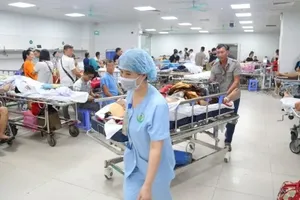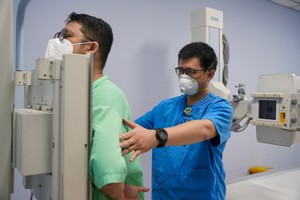
Politburo Resolution No. 72-NQ/TW (dated September 9, 2025) emphasizes health as “a person’s most precious asset” and foundation for the survival of the nation. Vietnam’s medical sector has since been relentless, achieving miracles like successful heart-lung transplants and groundbreaking fetal cardiac interventions. These procedures have truly turned the impossible into the possible, pulling lives back from the brink of existence.
Sheltering tiny warriors
On April 22, 2025, the Emergency Department at HCMC’s Tu Du Hospital reportedly fell silent, pierced only by agonizing moans. On a gurney, 40-year-old N.T.M. was doubled over, her hands clutching her abdomen as if to physically prevent her twins from being born. The fetuses were only 25 weeks old, a threshold considered perilously high for leaving the womb.
“Doctor, please save my babies!” she managed to whisper, her face pale before she fainted. Everything was a frantic, urgent rush. A doctor gently patted the mother’s hand, offering a reassuring nod that couldn’t quite hide his own deep concern.
A faint, fragile cry was heard. Two boys, weighing a mere 850g each, had entered the world in a hurry. The mother, depleted, lost consciousness. The infants were transferred immediately to the Neonatal Intensive Care Unit (NICU), a place where over 200 other fragile newborns were also fighting, hour by hour, inside their incubators.
Ventilators operating at maximum, the tiny bodies are in a “tangle of IV lines” in a constant “battle for survival.” The NICU’s 24/7 midwives are trained to catch every minute movement. Head Midwife Ngo Thi My Le explained, “We learn to ‘read’ the tiniest changes, often before the machines. Spotting something just one second earlier can save a life.”
Tragically, one of the twins didn’t make it. The devastated mother clung to the survivor, trying “kangaroo care.” But as she held him, the tiny body suddenly turned purple and went limp, requiring emergency resuscitation.
After two months of countless resuscitation attempts, the “true fighter” rallied. He was weaned off the ventilator and began to breastfeed. On July 12, 2025, the boy was discharged, healthy and weighing over 2kg. “Thank you,” the mother choked out, “thank you for keeping my son here and alive.”
Level-II Specialist Nguyen Thi Tu Anh, Head of the Neonatology Department at Tu Du Hospital, speaks of them with deep affection. “We call them our ‘tiny warriors,’" she said. “Because from the moment they first cry, they have to fight in those minuscule bodies, with lungs that aren’t mature and an immune system that isn’t complete. The challenges are just overwhelming, but we are simply not allowed to let go.”
For 32-year-old Vu Van Thinh from Da Nang City, the very first fetal intervention in early 2024 for his son was a success. His family was determined to give their child a chance, even though the technique was new to Vietnam. Two years on, the boy is developing exceptionally well, a testament to the family’s courage and the team’s talent.
A key weapon at Tu Du Hospital is its international-standard Breast Milk Bank, the “first vaccine” to reduce the risk of disease and death for the infants fighting in the incubators. In February 2025, the hospital also launched a European-standard NICU, a major leap forward. This has pushed the neonatal mortality rate below 1 percent, a statistic crystallized from “sweat, tears, love, and a resolute refusal to surrender to fate.”

Repairing tiny, faltering hearts
But it’s not just about saving these fragile lives after birth. Vietnamese medicine is now touching a frontier that was once unthinkable: repairing the heart while the baby is still a fetus.
On January 4, 2024, a medical event in HCMC sent shockwaves through the national and international medical communities. For the first time in Southeast Asia, a team from Children’s Hospital 1 and Tu Du Hospital successfully performed an intervention to repair the heart of a 32-week-old fetus.
With hands seasoned by nearly 20,000 congenital heart procedures, Do Nguyen Tin, MD PhD, Head of Cardiology at Children’s Hospital 1, carefully guided an 18-gauge needle. It passed through the expectant mother’s abdominal wall and into the fetal heart chamber, advancing toward the flawed right ventricle. The fetal heart, he described, was “the size of a strawberry”; one tiny slip could have stopped it. The doctor navigated to the pulmonary artery and successfully dilated the valve.
To prepare for those 40 minutes that would “change a fetus’s destiny,” the two lead hospitals in HCMC had been drawing up a battle plan for years, training their absolute best personnel for the team. In Vietnam, the Ministry of Health didn’t even have an official protocol for fetal cardiac intervention yet. It’s no surprise, then, that the team was “filled with trepidation.”
That anxiety finally dissolved on January 30, 2024, when a 2.9kg baby boy let out a robust cry at birth, the very same fetus who had been healed in the womb just weeks earlier.
The miracles continued. In May 2025, a Singaporean patient, pregnant after a 10-year struggle, was referred by KK Women’s and Children’s Hospital to HCMC for a severe fetal heart defect. After two tense interventions, the heart was successfully repaired on May 28, 2025. This achievement established the brand of Vietnamese medicine on the global medical map. By October 2025, the team’s 11th success had helped complete the legal dossier for official Ministry of Health recognition.
Statistics show congenital heart disease affects 1 percent of the population, with 12,000-15,000 new cases in Vietnam annually; 30 percent require neonatal surgery.
Level-II Specialist Nguyen Kinh Bang, Head of Surgery at the City Children’s Hospital, called this “an enormous challenge.” He vividly remembers operating on Nguyen Thi My Duyen, born at 29 weeks (1.7kg) with life-threatening heart defects. Surgery was the only option. Her tiny heart had to be stopped completely while a heart-lung bypass machine took over. After three grueling hours, her heart resumed its normal rhythm.
“My Duyen just came back for a check-up,” Nguyen Kinh Bang recounted, his eyes lighting up. “She’s 6 years old now, healthy and bright.” Watching her run, he saw the meaning of his work. Tens of thousands of tiny hearts, successfully repaired their laughter and futures made whole again.
Each year, Vietnam sees approximately 100,000 premature births (about 8 percent of all births). As the top-tier specialized hospital in the South, Tu Du Hospital alone handles over 54,000 births annually, with a premature birth rate of 15-17 percent. These infants face a myriad of risks, and prematurity reportedly accounts for a staggering 45 percent of all neonatal deaths.
























